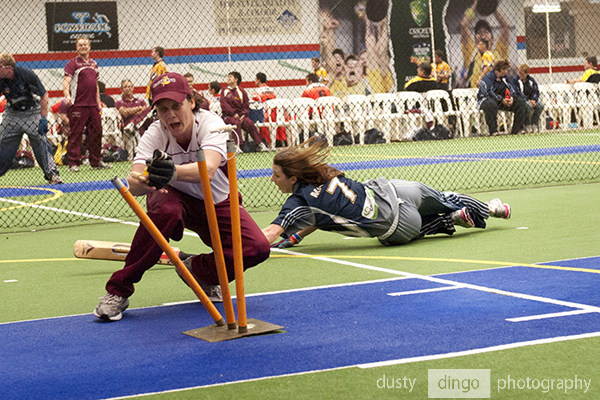The Rules
RULE
1. - FIELDING A TEAM
RULE 2. -
THE GAME
RULE 3. -
UNIFORMS
RULE 4. -
THE TOSS
RULE
5. - PLAYING EQUIPMENT
RULE 6. -
THE UMPIRE
RULE 7. -
ARRIVAL/LATE PLAYER(S)
RULE 8.
- PLAYER SHORT / SUBSTITUTES / INJURED PLAYERS
RULE 9. - FIELD
PLACEMENT.
RULE
10. - PLAY BALL/LIVE BALL/DEAD BALL.
RULE 11. -
SCORING.
RULE 12. - NO
BALL.
RULE
13. - WIDE AND LEG SIDE WIDE BALLS.
RULE 14. - BOWLER
CHANGING DIRECTION/STYLE.
RULE 15. - BALL
LEAVING THE PLAYING AREA.
RULE 16. -
APPEALS FOR DISMISSALS.
RULE 17. -
DISMISSALS.
RULE 18. -
INTERFERENCE.
RULE 19. -
MISCONDUCT.
RULE 20. - ORDER OFF.
RULE 21. - ILLEGAL COURT
ENTRY/EXIT.
RULE 22. -
RUNNERS.
RULE 23. - END OF GAME.
RULE 24. - MIXED GAMES.
SECTION 2 - AICF STANDARDS
1.
COURT LAYOUT AND
DIMENSIONS.
2. EQUIPMENT.
SECTION 3 - MANAGEMENT PROCEDURES
1.
GAME FEES.
2. LATE STARTS.
3. PREMIERSHIP AND BONUS POINTS.
4. LADDER POSITION.
5. FINALS QUALIFICATIONS.
6. DRAWN FINAL.
SECTION 4 - VARIATIONS.
SECTION 5 - UMPIRE SIGNALS.
Umm . . not out?

An analysis and explanation (where possible) of the Rules of Indoor Cricket

April 2021. We are still working hard at revamping the layout and content of the site, and have moved it to a mobile-friendly platform. And we are doing all the recoding etc ourselves . . . so please ignore all obselete references to the defunct Australian Indoor Cricket Federation (AICF), such anomolies will be corrected as we work our way through the site. Thank you . . . now, back to the rules . . .
These are the rules in use around Australia, most affiliated (with the World Indoor Cricket Federation . . . cough . . . ) countries, and officially sanctioned international matches and tournaments.
The rules I mostly concentrate on here are those directly relevant to players, umpires, and those seeking to inform themselves of the sport.All the rules below were included in the "official" AICF rulebook, and it looks like they're still in use even though Cricket Australia has taken over the running of Indoor Cricket (after years of decrying Indoor Cricket as a bad thing for "real" cricket players).
For cross-referencing ease, I have arranged and numbered the rules below to match the AICF rule-book, and surprisingly that matches the new rule books . . .
The rules as presented here are my interpretation only, and the attached comments and tips are also my interpretation only. I have clearly identified where I believe my interpretation differs from the "official" one. I should add I am an AICF-trained and qualified Level 4 umpire, having officiated over National Open championships and international matches. I am also AICF-qualified to train umpires up to Level 4.
Note: a couple of terms which will crop up often in the following pages may need explanation.
"Off" side and "On" side - definitely not to be confused
with the football terms.
The ON, or Leg side (not to be confused with leg-side wides
either) is the side of the pitch behind the batsman when the
batsman is standing ready to receive the bowled ball. That is, if
a right-handed batsman looks down the pitch toward the bowler, the
Leg or On side is the half of the court to the batsman's left of
the pitch.
The Off side is the other side of the court.
So a batswoman playing a shot "to leg" or "to the On side" is
hitting the ball into the left side of the court. If she plays an
"Off" drive, she has hit the ball to the right side. For
left-handed batswomen, the reverse applies.

And one other little point - indoor cricket is played by both
males and females. Therefore the term batsman as a general
term is inaccurate. However, "batters" play softball and baseball,
and I'm talking about cricket. Therefore, I ask the female
reader's indulgence and tolerance when I use the male form when
describing aspects of the game. "He/she" is clumsy, "batters" just
plain wrong, and "batspeople" too silly for words. As part of the
revamp of the site, I am going through and making some examples
relevant to male players (he does this, the batsmen do this) and
some relevant to females (she does this, the batswomen do that).
But until then, indulge and tolerate? .... thank you.